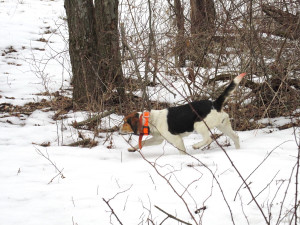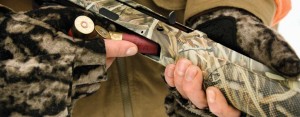Now that deer gun season in Ohio is over, there are still ample opportunities to hunt. It’s still open season for a wide variety of small game animals, including furbearing animals and predators.
And, of course, you can continue hunting deer with archery through Feb. 5., and there’s the four-day muzzleloading season in January.
But until then, now is also a good time to catch up on one animal in particular that I’ve always enjoyed hunting: cottontail rabbits.
Rabbit season is open through the end of February. I’ve been hunting rabbits since I was a young boy. My family has hunted rabbits for as long as I can remember, and we’ve always used beagle dogs. To be honest, the dogs are what make rabbit hunting most enjoyable.
There’s no better feeling than to watch and listen to your dogs bring a rabbit around for you to shoot. The sound that beagles make when hot on the trail of a rabbit is hard to describe. It’s kind of a long, deep, drawn out bark that some people call “baying.” You can see what I mean in this video.
Below the video, I offer a few tips on rabbit hunting. I’m no expert, but I’ve learned a few things over the years, and I continue to learn even more.
• • •
1. “Jumping one up.” The first thing you’ll need to do to get yourself a rabbit is “get one up,” usually from a brush pile or a field of tall grass. Rabbits seek the thickest cover they can find, to hide from predators and also humans. Even if you don’t have dogs, you can get a rabbit up and running by walking through these thick areas, or at least kicking them with your feet, or throwing something heavy, like a tree branch, into the middle. And be ready, because if you don’t have dogs to bring the rabbit back, you’ll probably have to shoot as soon as one gets up.
2. Lead your shot. If you’re going to be shooting at close range, such as when you first jump one up, it’s a good idea to aim a little in front of the rabbit, or at least no closer onto him than his nose. If you’re using a shotgun, which is what most people prefer, you’ll get plenty of width in your shot pattern to just hit his head, damaging less meat. Of course, if you’re using a .22 rifle or something more precise, you can aim perfectly for the head, but doing so when he’s running is extremely difficult.
3. Use the right equipment. To hunt rabbits right, you need to get in the brush and the briars, and that means wearing clothing that can take a beating. Try to buy something durable and made in the United States. Heavy fabric, duck bibs and overalls work well, and there’s a few brands that make “briarproof” clothing that are worth the money. If it’s going to be cold (and it usually is during rabbit season) seek out something with insulation. And if it’s a warmer day, consider a pair of chaps or uninsulated bibs. And most importantly, be sure and wear all of the appropriate hunter orange. Not only is it the law, but you’ll be doing yourself a big favor by making yourself more visible to other hunters.
4. Choose your weapon. I’ve heard of people hunting rabbits with bow and arrow, but “heard of it” is about the extent of it. I prefer to go with a shotgun, and I prefer a lighter choice, such as a 20 gauge, which still throws plenty of lead — but less than the 12 gauge. This makes me aim a little closer, and the smaller impact also damages less meat.

For ammunition, I prefer anything in the No. 6 shot lead, although you can also No. 5, and 7 1/2. My all-time favorite load for rabbits is the Remington Express Long Range, which produces a good pattern. One of these days I’m going to go back to using my .22 rifle, but that almost requires a still rabbit.
5. Get yourself some dogs. This is usually easier said than done, especially if you want good, dependable dogs. I don’t even have good dogs myself — at least not right now — but they’re “good enough.” What you want is a beagle, or a group of beagles, that can jump a rabbit, smell the trail, follow the trail, and bring the rabbit back around to where you’re standing. When chased by a dog, rabbits typically run a large circle, or semi-circle around the acre or so where they’re jumped, and if the dog keeps the trail, the rabbit eventually comes full-circle, to where the hunter is waiting and can get a good shot.

Experienced hunters know this, and wait patiently and readily for the rabbit to come hopping back to wherever he was first jumped. Keep quiet and keep watching, because as long as the dogs are still barking, the rabbit is still on his way back. If you move or make noise, he’ll hear you and jolt away in another direction.
6. Identify your target. This is especially important when hunting with dogs, but is important whenever you hunt. Thinking you see a rabbit isn’t good enough, even when you hear your dogs barking and you believe the rabbit is near. You might see some brush move or even see a flash of brown — but it could be one of your own dogs — or a cat — for all you know. Wait until you identify it as a rabbit, and make sure your dogs aren’t so close to the chase that you hit them with stray pellets. It sounds awful and it is, but when a dog is just a few feet behind a rabbit, and you shoot, you risk getting both the rabbit and the dog.
7. Form a strategy. Each area you hunt is going to be a little different from the next, but you can usually make a pretty good game plan before you get started. If it’s a long, narrow strip, such as an old fenceline or creek bottom, try to keep your dogs in the middle and your hunters on the outside. As you walk the strip, you’ll have a good look at anything that breaks to the outside, and if you’re dogs stay in the middle, they’re more likely to jump something up.

8. Work together. If you’re hunting alone, a large woods can be hard to cover, but if there are two or more hunters, you can spread out and walk through the woods in a line. A good line ensures that anything along your route is going to get up (or go down a hole). I like to keep about 30 yards between myself and the next hunter, but that all depends on how thick the area is. In thicker areas, you’re better off closer together, so you can see what gets up and direct your dogs to that area.
9. Be patient. If you’re hunting with dogs, you usually don’t need to shoot when a rabbit first gets up. I prefer giving the dogs a chance to work and bring the rabbit back around. And a returning rabbit is almost always going to result in a cleaner kill, with less damage to the meat.
10. Respect your dogs. Your dogs won’t always pick up the trail, and they definitely won’t always keep the scent. This can happen for a variety of reasons, but the thing is, it happens. When they lose one trail, move on to another. And when they bring a rabbit back and you get it, show it to the dogs so they can see the fruits of their labor. Also, be mindful of anything else your dogs might be chasing, including deer.

It’s good to be social with your dogs, rewarding them for good behavior and scolding them when they misbehave. It’s also good to have shock collars on them, just in case. Most shock collars allow you to send a warning sound to the dogs before you shock them, but if you absolutely must, it’s far better to shock a dog than to have him get out onto the road, or to run away for miles chasing a deer.











When a beagle is hot on a rabbit
How you can tell if they are lying and running some thing different?
By his rate of travel, his pausing to howl, etc. Let him chase a few rabbits, and you’ll almost be able to see the rabbit in front of him in your mind. A fast-trailing dog will run a rabbit in a wider circle. A slow dog will run him in a tighter circle. Opossums & squirrels will be up a tree. A dog on a deer will be gone, gone, gone.
Another trick: for years I’d scolded my dogs for running deer. Simply get some deer scent on a rag and put it in their crate or tie it around their collar. When they smell it in the woods, it’ll be no big deal to them. Rabbit smell will be what they’re after.
I got here some essential and more proven methods resources, thanks a lot for this best idea